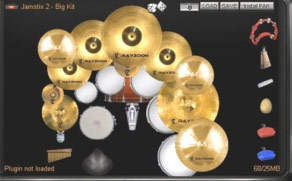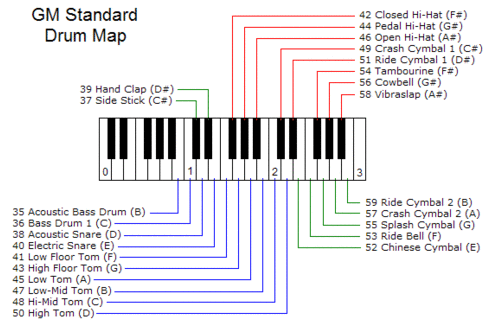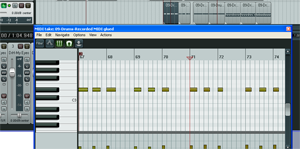Drumming Without Drums – Use A Virtual Drumming App OnYour Computer

One of the coolest things about recording music on our computers is virtual instruments.
And one of the most common and useful instruments are virtual drum apps.
For some basics on virtual instruments, see my post What is A Virtual Instrument? Play Music Without Having To Know How To Play Instruments.
Like I said, of all the different kinds of instruments we can play on our computers, drums are probably the most used. And why not? You can have a drum track on your song without even touching a drum.
Technically you don’t even have to know how to play drums (though I think it helps a LOT if you can) in order to have them in your recordings. And perhaps the biggest benefit for my wife – I don’t have to make all the racket in the house that a drum kit would create.
No loud drum kit to bug the neighbors
This is also a plus if you live in an apartment and drums would generate neighbor complaints. One of the down-sides to all this is that it’s actually fun to play drums for real! But finding a place for the kit to live is hard if you don’t have a lot of space in your house. Plus, even though it’s a lot of fun to play drums, recording them is typically not easy.
In order to record live drums, not only do you have to have a drum kit. You need somewhere to put it and a drummer good enough to be on your recording. You have to have a bunch of additional microphones.
For example, the kick drum needs a certain kind of mic (like an AKG D 112, for example) that is very different from the snare drum (typically a Shure SM57 or two). And that is very different from what you’d need for overheads (2 large diaphragm condensers like the Rode NT2-A). So by using virtual drums, you’re saving yourself a lot of money for mics if nothing else.

So what is virtual drumming anyway? Well, if you’re recording a song, you can load up a software plug-in/virtual drumming app into your multi-track recording software. I like to use Reaper. Once you load the program onto a track, your computer can play these drums via MIDI. It’s like having a drum machine inside your computer.
There are several different ways you can build a drum part. For those of us who are control junkies, you can do it like me. I like to build my tracks one measure at a time using my MIDI keyboard (I use a Korg controller).
Drum programs (I like to use StormDrum by EastWest) will typically assign each drum in a kit to a specific key on a MIDI keyboard. See Figure 1. I will turn on the metronome in Reaper to keep me on the right tempo, and play, say, the kick (bass) drum part for a measure or two by simply playing the “C” key on my keyboard.
Then I’ll do the same for the snare drum part, using the “D” and “E” keys (note: sampled drum programs typically deviate from the GM standard mapping by putting 2 different snare hits, left hand and right hand, on the “D” and “E” keys to allow your to play them like you had a drum stick in each hand.
This makes the virtual drums sound very realistic. I will repeat the above procedures for high-hat, toms and symbols until I have my song’s drum part composed for the entire song.
You just go into Reaper’s MIDI editor (See Figure 2) and drag a bar left or right (for timing) or up/down, which changes the note/drum being struck. By the way, I go into more detail on this in our first article on virtual drumming if you’d like to dig into this a bit more.
Benefit of MIDI for virtual drumming
One of the greatest things about MIDI is that you’re not recording audio. You’re recording “on” and “off” messages, along with some additional information like how hard you hit the drum, volume, etc. So it is super easy to correct the beats if you were a little ahead or behind or hit the wrong drum, when you played them on your keyboard.

So that is one way to do virtual drumming, which is admittedly a bit time-consuming. Here’s another way to it that is definitely faster.
Virtual drumming AI for faster programming
There’s a program called Jamstix that has a sort of artificial intelligence. You load the program on a track in Reaper, open it up, and then select a type of drum kit.
There are multiple genres, like R&B, Rock, Jazz and Latin), and several different kit-types within each genre. For example, the Rock genre contains such variations as Big Kit, Classic, Deep Loose, Deep Modern, Dry, Fat, Boom, etc. Once the kit is loaded, you can select a preset song like “12-Bar blues,” “808 Hip Hop,” “Metal,” etc. and voila! Just hit “play” in Reaper and the drums will start playing at whatever tempo you have set in Reaper currently.
Jamstix use modules (Intro, Verse, Pre-Chorus, Chorus, Bridge, Middle-8, Drum Solo, Silence, Link, Breakdown, and Ending) to build songs. You can build your own songs (especially great for composing) or use the presets by selecting modules and putting them in whatever order you want. Of course you can also customize your songs in detail if you wish. Jamstix is awesome.
There are lots of methods in between loading up preset songs and building your own beat-by-beat. And there are lots of different programs you can use for this. Different drum programs will have different ways to do your virtual drumming.
Here are a few other quite popular drum programs that are known to work well with Reaper:
– Toontrack EZ-Drummer – Virtual Drum Module Plug-In
– Addictive Drums – Complete Drum Production Studio
– FXpansion BFD – Software Instrument for Acoustic Drums
So there are some ways you can use virtual drumming to put drums onto your recordings without actually possessing a single actual, physical drum.
With the quality of recorded drum samples available today, a large percentage of folks listening to your recordings won’t be able to tell that your “drums” aren’t real. This is a great time to have a home recording studio:).
Happy (virtual) drumming!
